Alaska, the largest state in the United States, is known for its harsh winters and breathtaking landscapes. It is home to diverse wildlife, including a stunning variety of winter birds.
These remarkable creatures have adapted to the extreme cold and the challenges that come with it, making Alaska a unique and essential habitat for bird enthusiasts and nature lovers.
From the majestic bald eagles to the tiny, resilient chickadees, winter birds in Alaska captivate our attention with their remarkable ability to survive and thrive in this frozen wilderness.
Join us as we embark on a journey to explore these fascinating winter birds and discover the wonders they bring to this extraordinary place.
50 Winter Birds in Alaska
Whether you’re an avid birder or enjoy observing wildlife, these feathered creatures will captivate you during the chilly months.
Here are 50 winter birds you might encounter in Alaska.
1. Black-Capped Chickadee
The black-capped chickadee is a small songbird found in North America. It is known for its distinctive black cap and white cheeks.
This bird is not migratory, meaning it does not travel long distances during different seasons. The black-capped chickadee prefers to live in deciduous and mixed forests.
These types of forests provide the bird with the necessary habitat, such as trees and shrubs, where it builds its nests and finds food.
As a passerine bird, it belongs to the tit family, which is scientifically called Paridae. Interestingly, the black-capped chickadee holds special significance in certain regions.
It is the state bird of Massachusetts and Maine in the United States, symbolizing its importance to the local environment and culture.
Additionally, in Canada, specifically in the province of New Brunswick, it is recognized as the provincial bird. The black-capped chickadee is a small, nonmigratory songbird found in North America.
It thrives in deciduous and mixed forests and belongs to the tit family. Its significance is acknowledged through its designation as the state bird in Massachusetts and Maine and the provincial bird of New Brunswick.
| Kingdom | Animalia |
| Phylum | Chordata |
| Clade | Dinosauria |
| Class | Aves |
| Order | Passeriformes |
| Family | Paridae |
| Genus | Poecile |
| Species | P. atricapillus |
2. Bohemian Waxwing
The Bohemian waxwing is a bird about the same size as a starling.
It belongs to a group of birds called passerines, which means it has feet adapted for perching and a specialized beak for eating seeds and fruits. These birds can be found in the northern forests of two regions: the Palearctic and North America.
The Palearctic includes Europe, Asia, and northern Africa. In North America, they are commonly found in Alaska and Canada. The plumage of the Bohemian waxwing is buff-grey mainly. Buff refers to a pale yellowish-brown shade.
So, the bird has a combination of grey and buff feathers covering its body. This coloration helps the bird blend in with its surroundings, providing camouflage in the forest. One distinctive feature of the Bohemian waxwing is its black face markings.
These markings are visible on both sides of its face and are essential for identification. The black color contrasts with the bird’s overall plumage, making it stand out. Another noticeable feature of the Bohemian waxwing is its pointed crest.
A crest is a tuft of feathers on the bird’s head.
| Kingdom | Animalia |
| Phylum | Chordata |
| Clade | Dinosauria |
| Class | Aves |
| Order | Passeriformes |
| Family | Bombycillidae |
| Genus | Bombycilla |
| Species | B. garrulus |
3. Pine Grosbeak
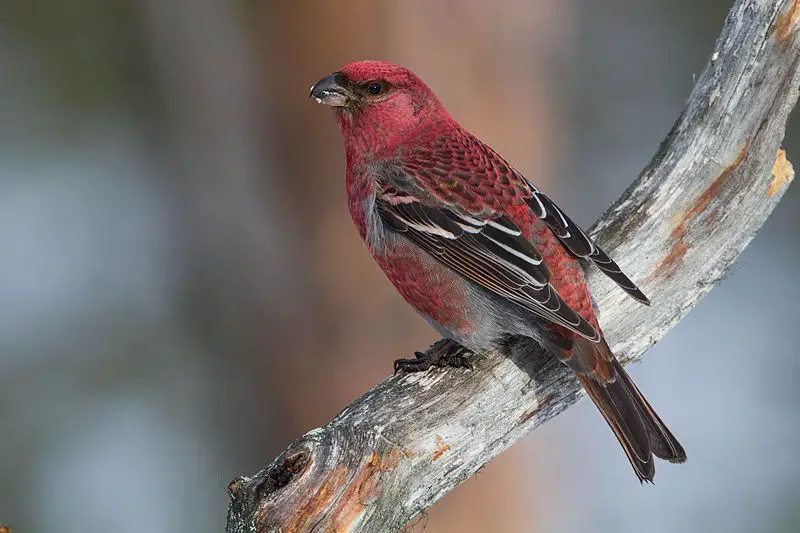
The pine grosbeak is a type of bird that belongs to the true finch family called Fringillidae. It is pretty big compared to other finches. It is the most prominent member of its family.
The pine grosbeak is the only species in its genus, meaning no other birds are closely related to it. This makes it unique and distinct from other birds in the true finch family. These birds are commonly found in areas with coniferous woods.
This includes regions like Alaska, the western mountains of the United States, Canada, and parts of Fennoscandia. Fennoscandia refers to the northern European region of Norway, Sweden, Finland, and parts of Russia.
Subarctic Fennoscandia experiences cold temperatures and is covered by forests, making it a suitable habitat for the pine grosbeak. Not only is the pine grosbeak present in North America and Fennoscandia, but it also extends its range across the Palearctic region.
The Palearctic includes Europe, Asia, and North Africa. In this vast area, the pine grosbeak can be found in Siberia.
| Kingdom | Animalia |
| Phylum | Chordata |
| Clade | Dinosauria |
| Class | Aves |
| Order | Passeriformes |
| Family | Fringillidae |
| Genus | Pinicola |
| Species | P. enucleator |
4. Woodpeckers
Woodpeckers belong to a bird family called Picidae. This family also includes other birds like piculets, wrynecks, and sapsuckers. Members of the Picidae family can be found all around the world, except in certain places.
Australia, New Guinea, New Zealand, Madagascar, and the extreme polar regions are where these birds are not found. Woodpeckers are unique birds known for their ability to peck and drum on trees.
They have specially adapted beaks and strong neck muscles that allow them to strike trees repeatedly. This behavior is used for feeding, communication, and establishing territories. Piculets are smaller woodpecker-like birds that belong to the Picidae family.
They have similar physical characteristics and behaviors as woodpeckers, but they are usually smaller in size. Wrynecks, another member of the Picidae family, are small, insect-eating birds with long, slender bills.
They are known for their ability to twist their necks in a snake-like fashion. Sapsuckers, also part of the Picidae family, are woodpeckers with unique feeding habits. They drill small holes in trees.
| Kingdom | Animalia |
| Phylum | Chordata |
| Clade | Dinosauria |
| Class | Aves |
| Order | Piciformes |
| Family | Picidae |
5. Canada Jay
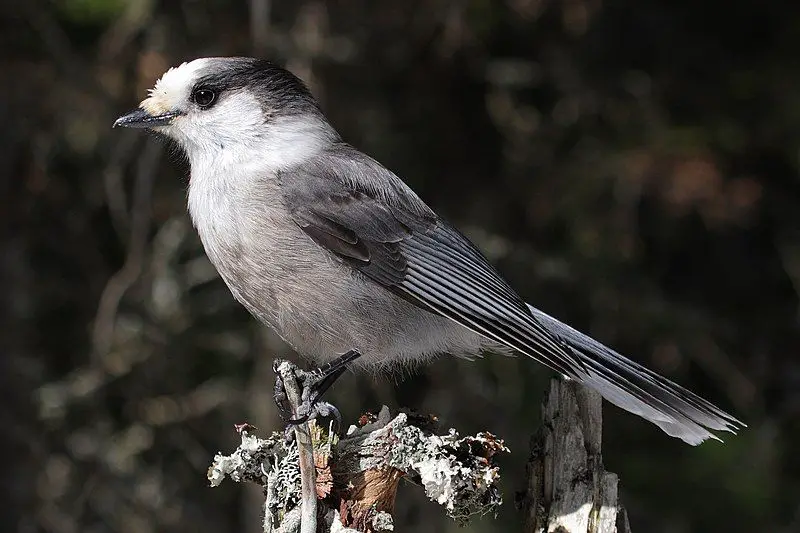
The Canada jay is a type of bird that belongs to the Corvidae family. It is also known by other names such as the gray jay, grey jay, camp robber, or whisky jack.
This bird is commonly found in the boreal forests of North America. The Canada jay can be seen in regions stretching from northern North America up to the tree line.
It is known to inhabit areas with boreal forests, characterized by dense and extensive growth of coniferous trees. In addition to its presence in boreal forests, the Canada jay can also be found in the subalpine zone of the Rocky Mountains.
This zone is located at higher elevations and is characterized by a mix of coniferous and deciduous trees.
The bird’s range extends southward in this zone, reaching as far as New Mexico and Arizona. The Canada jay’s ability to adapt to different environments is evident in its wide distribution across North America.
It can survive in the cold and harsh conditions of the boreal forests and the subalpine zone of the Rocky Mountains. One interesting behavior of the Canada jay is its tendency to steal food from other animals.
| Kingdom | Animalia |
| Phylum | Chordata |
| Clade | Dinosauria |
| Class | Aves |
| Order | Passeriformes |
| Family | Corvidae |
| Genus | Perisoreus |
| Species | P. canadensis |
6. Rock Dove
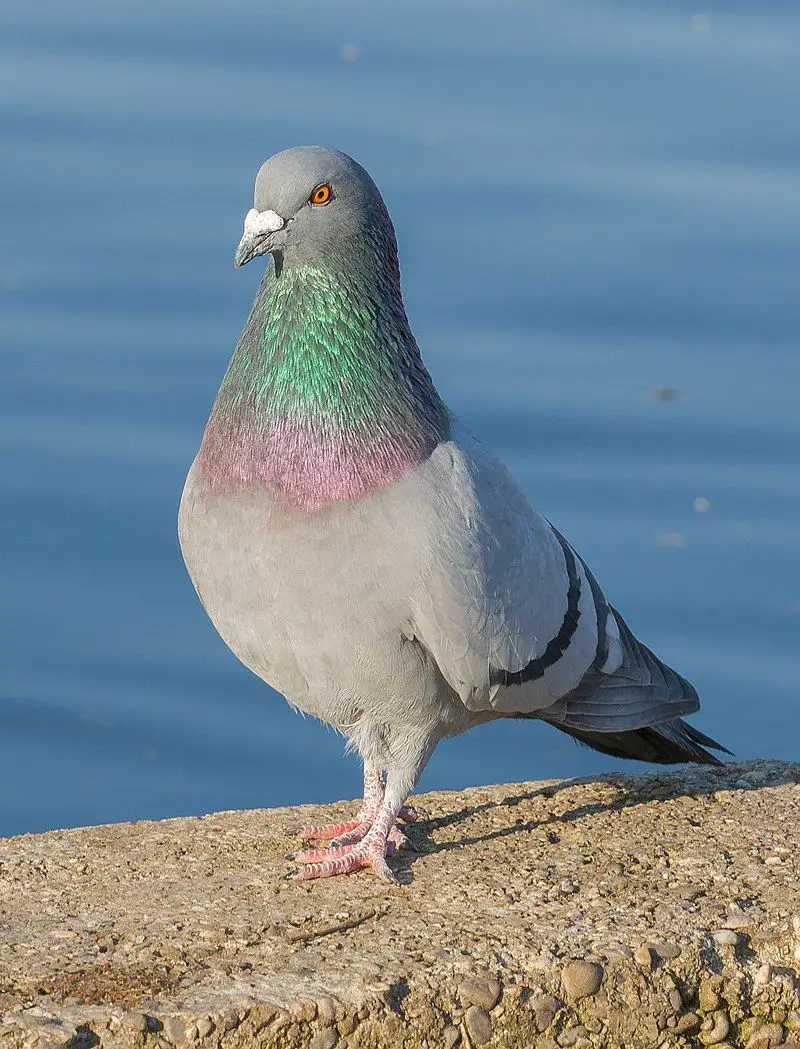
The rock dove, also known as the rock pigeon or common pigeon, belongs to the bird family Columbidae. Many people commonly refer to it as simply the “pigeon.” The domestic pigeon is a descendant of this species.
When domestic pigeons escape captivity, they have contributed to the rise in feral pigeon populations worldwide. The rock dove, or rock pigeon, is a type of bird that belongs to the Columbidae family. It is often called a pigeon in everyday language.
This species has given rise to the domestic pigeon through generations of breeding. Domestic pigeons are descended from the rock dove species.
Over time, humans have selectively bred these birds for various traits, developing different pigeon breeds.
Domestic pigeons are often kept as pets or used in pigeon racing and other sports. However, sometimes, domestic pigeons escape or are released into the wild. These pigeons, adapted to living with humans rather than in the wild, are known as feral pigeons.
Feral pigeon populations have increased globally due to the presence of escaped domestic pigeons. Escaped domestic pigeons can interbreed with feral pigeons, further contributing to their population growth.
| Kingdom | Animalia |
| Phylum | Chordata |
| Clade | Dinosauria |
| Class | Aves |
| Order | Columbiformes |
| Family | Columbidae |
| Genus | Columba |
| Species | C. livia |
7. Red-Breasted Nuthatch
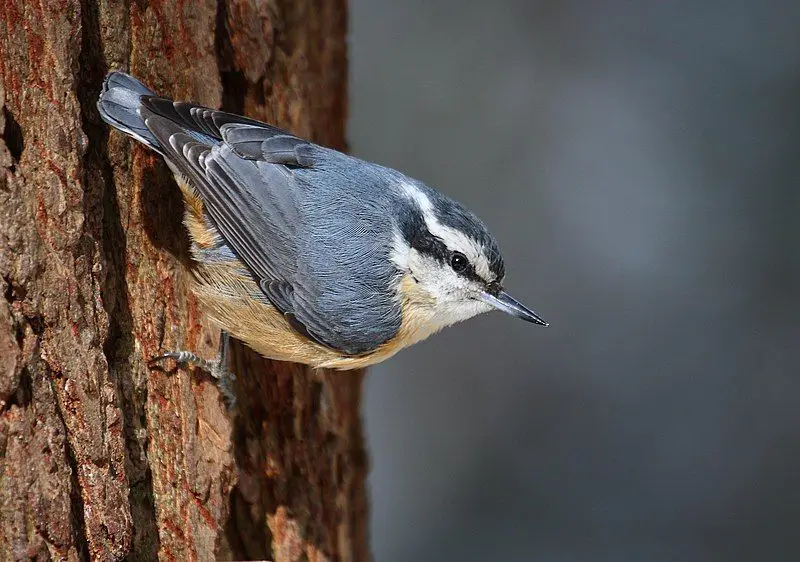
The red-breasted nuthatch is a small bird known for its beautiful appearance and unique characteristics. It has blue-grey feathers on its upper body and cinnamon-colored feathers on its underparts.
This combination of colors creates a striking contrast. Looking closely at the red-breasted nuthatch, you will notice a white throat and face. These white areas provide a stark contrast against the rest of its body.
Additionally, a distinct black stripe runs through its eyes, giving it a charming and distinctive look. Another notable feature of the red-breasted nuthatch is its straight grey bill.
This bill is perfectly shaped for its feeding habits, allowing it to crack open seeds and nuts easily. The bird’s bill is functional and adds to its overall appearance. One of the most striking features of the red-breasted nuthatch is its black crown.
This black area on its head gives the bird a regal and elegant look. Combined with its blue-grey and cinnamon colors, the black crown adds a touch of sophistication to its appearance. Apart from its visual characteristics, the red-breasted nuthatch has a unique call.
Described as a tin trumpet, its call is high-pitched.
| Kingdom | Animalia |
| Phylum | Chordata |
| Clade | Dinosauria |
| Class | Aves |
| Order | Passeriformes |
| Family | Sittidae |
| Genus | Sitta |
| Species | S. canadensis |
8. Boreal Chickadee
The boreal chickadee is a small bird belonging to the passerine songbird family called Paridae. It is commonly found in the boreal forests of Canada and the northern regions of the United States.
These birds do not migrate and can be seen in their designated range throughout the year. The boreal chickadee’s small size allows it to navigate through the dense vegetation of the boreal forests easily.
Its distinctive appearance features a grayish-brown body with a black cap and bib. The bird also has white cheeks and a white patch above its eyes. These chickadees are well-adapted to survive in cold climates and harsh conditions.
They have a thick layer of feathers that helps insulate their bodies, keeping them warm during the cold winter.
Additionally, they can lower their body temperature during frigid nights, conserving energy and reducing heat loss. The diet of the boreal chickadee primarily consists of insects, seeds, and berries.
In the winter, when insects become scarce, they rely more on seeds and berries for sustenance. These birds are known for their acrobatic foraging skills, often hanging upside down from branches to reach their desired food sources.
| Kingdom | Animalia |
| Phylum | Chordata |
| Clade | Dinosauria |
| Class | Aves |
| Order | Passeriformes |
| Family | Paridae |
| Genus | Poecile |
| Species | P. hudsonicus |
9. Black-Billed Magpie
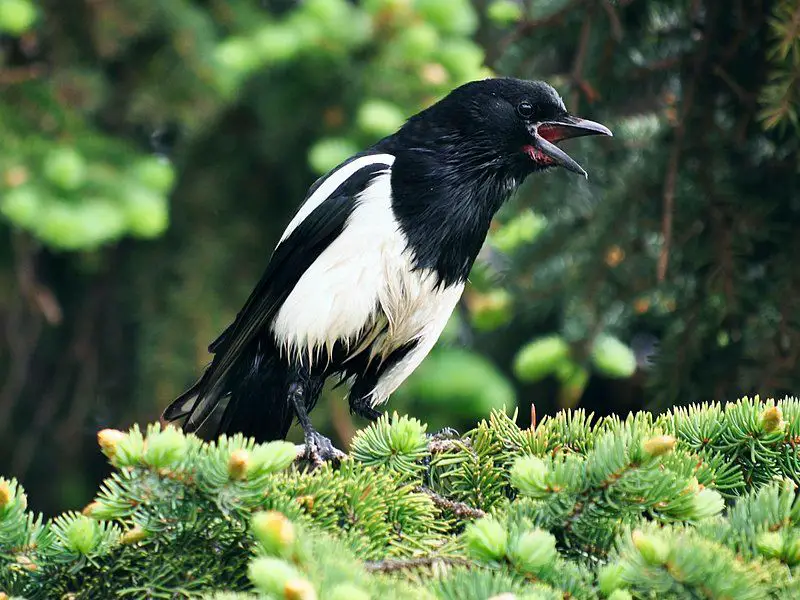
The black-billed magpie is a type of bird that belongs to the corvid family. It can be found in the western part of North America. Another name for this bird is the American magpie. In terms of appearance, the black-billed magpie is primarily black and white.
Its body is mainly black, but it also has areas of white feathers. These black and white colors create a striking contrast. The wings and tail of the black-billed magpie have black feathers as well.
However, looking closely, you may notice that these black areas have hints of iridescent colors like blue or blue-green.
When the light hits its feathers, these colors give the magpie a beautiful shimmering effect. The black-billed magpie is a visually appealing bird due to its contrasting black and white colors.
The iridescent hints of blue or blue-green on its wings and tail add extra beauty to this already remarkable creature.
| Kingdom | Animalia |
| Phylum | Chordata |
| Clade | Dinosauria |
| Class | Aves |
| Order | Passeriformes |
| Family | Corvidae |
| Genus | Pica |
| Species | P. hudsonia |
10. Common Redpoll
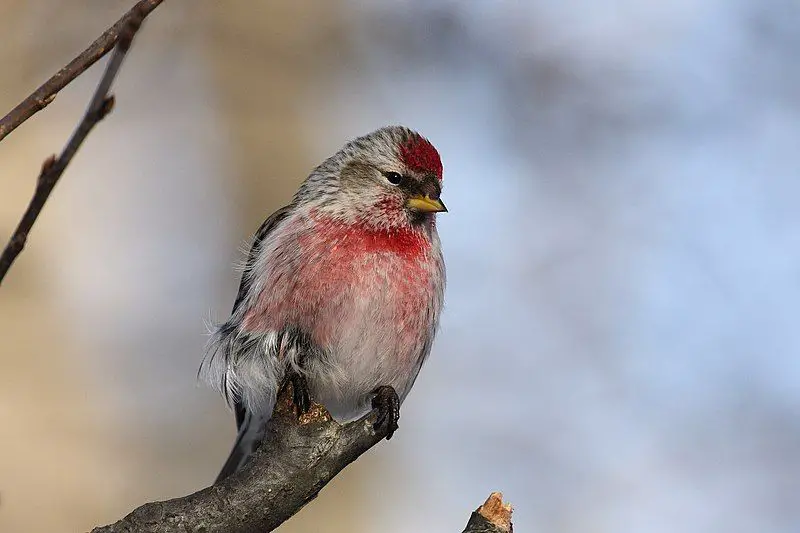
The common redpoll, also known as the mealy redpoll, is a type of bird. It belongs to the finch family, which includes other small birds with cone-shaped beaks.
The common redoll is found in various regions. Unlike the Arctic redpoll, the common redpoll breeds in areas slightly closer to the south. It prefers habitats that have thickets or shrubs.
These habitats provide the necessary resources and shelter for the bird to survive and reproduce. Thickets are dense areas filled with small trees or bushes. They often offer protection from predators and harsh weather conditions.
On the other hand, shrubs are woody plants smaller than trees but larger than herbs.
Both thickets and shrubs provide the common redpoll with suitable nesting sites and a source of food. The availability of resources such as seeds, fruits, and insects may influence the common redpoll’s choice of breeding habitat.
Thickets and shrubs can offer the bird a diverse range of food options, helping it meet its nutritional needs during the breeding season. It is important to note that the common redpoll and Arctic redpoll are two separate species.
While they may share some similarities, such as their finch family classification.
| Kingdom | Animalia |
| Phylum | Chordata |
| Clade | Dinosauria |
| Class | Aves |
| Order | Passeriformes |
| Family | Fringillidae |
| Genus | Acanthis |
| Species | A. flammea |
11. Two-Barred Crossbill
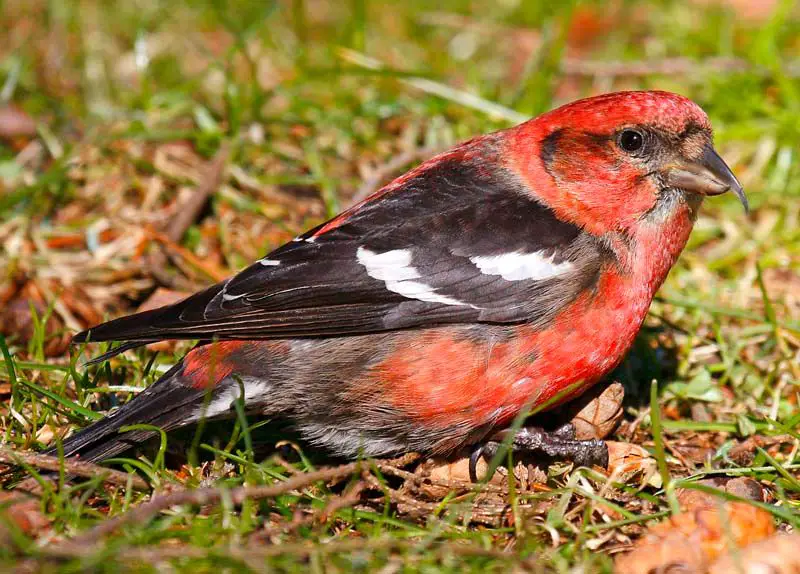
The two-barred crossbill, also known as the white-winged crossbill, is a type of bird. It belongs to the finch family called Fringillidae.
This bird is relatively tiny and classified as a passerine bird, meaning it has feet designed for perching. The two-barred crossbill can be found in the coniferous forests of North America and the Palearctic region.
These forests have trees that bear cones, such as pine, spruce, and fir trees. The crossbill has adapted to its habitat by developing a specialized beak. The beak of the two-barred crossbill is unique and helps it survive in its environment.
The upper and lower parts of the beak cross over each other, forming a shape similar to a pair of crossed scissors.
This specialized beak allows the bird to pry open the scales of conifer cones to access the seeds inside. The two-barred crossbill has a reliable food source by feeding on the seeds found within conifer cones.
This is especially important during the breeding season when the bird needs to nourish itself and its young. The crossbill’s ability to extract seeds from cones gives it an advantage over other bird species.
| Kingdom | Animalia |
| Phylum | Chordata |
| Clade | Dinosauria |
| Class | Aves |
| Order | Passeriformes |
| Family | Fringillidae |
| Genus | Loxia |
| Species | L. leucoptera |
12. Pine Siskin
The pine siskin is a type of bird found in North America. It belongs to the finch family, which includes other small birds like sparrows and goldfinches.
The pine siskin is known for its ability to migrate, meaning it travels from one place to another depending on the season. During the winter, the pine siskin’s range becomes very unpredictable.
It moves around sporadically instead of following a specific pattern or staying in one place.
Predicting where precisely these birds will be during the winter months can be challenging. The reason behind the pine siskin’s sporadic winter range is not entirely understood.
It is believed that factors like food availability and weather conditions play a role in determining their movements.
When specific food sources become scarce in one area, the birds may move to another location in search of better resources. The pine siskin’s winter range can vary from year to year.
One winter, they might be seen in large numbers in a particular region, while the following winter, they may be scarce or absent from the same area.
This unpredictability adds to the bird’s unique characteristics and makes it an interesting species to study. Researchers and bird enthusiasts often.
| Kingdom | Animalia |
| Phylum | Chordata |
| Clade | Dinosauria |
| Class | Aves |
| Order | Passeriformes |
| Family | Fringillidae |
| Genus | Spinus |
| Species | S. pinus |
13. Rock Ptarmigan
The rock ptarmigan is a type of bird that belongs to the grouse family. It is medium-sized, not too big or too small. In the United Kingdom, it is called “ptarmigan.” This bird holds a special place in Canada.
In the Canadian territory of Nunavut, the official bird is called “aqiggiq.” Additionally, in the provinces of Newfoundland and Labrador, it is the official game bird. The rock ptarmigan is known for its distinct features and characteristics.
It has a unique appearance with its mottled plumage, which helps it blend in with its surroundings. This serves as a protective mechanism from predators. The bird’s feathers change color according to the season.
In winter, they become white to match the snowy landscape; in summer, they turn brown to match the rocky areas where they reside. Living in the cold regions of Canada, the rock ptarmigan has adapted to survive in harsh conditions.
It has specialized feathers on its feet that act as snowshoes, enabling it to walk on deep snow without sinking. Additionally, its diet consists mainly of plant material such as buds, leaves, and berries, available even during winter.
| Kingdom | Animalia |
| Phylum | Chordata |
| Clade | Dinosauria |
| Class | Aves |
| Order | Galliformes |
| Family | Phasianidae |
| Genus | Lagopus |
| Species | L. muta |
14. Common Raven
The common raven is a bird known for its large size and black feathers. It belongs to a group of birds called passerines, which means it has feet adapted for perching.
The raven is not only a passerine but also a member of the corvid family, which includes other intelligent birds like crows and jays. One interesting fact about the common raven is its wide distribution. It is found in many different places across the Northern Hemisphere.
This means you can spot ravens in various countries and regions, from North America and Europe to Asia. The raven’s black coloration is one of its defining features. Its feathers are entirely black, giving it a sleek and glossy appearance.
This monochromatic plumage helps the bird blend into its surroundings, making it less visible to potential predators or prey. Apart from its appearance, the common raven is also known for its intelligence.
It is considered one of the most intelligent bird species, capable of problem-solving and tool use. Ravens have been observed using sticks and other objects to reach food or manipulate their environment. In terms of behavior, ravens are highly social creatures.
They are often seen in pairs or small groups, communicating with each other.
| Kingdom | Animalia |
| Phylum | Chordata |
| Clade | Dinosauria |
| Class | Aves |
| Order | Passeriformes |
| Family | Corvidae |
| Genus | Corvus |
| Species | C. corax |
15. Bald Eagle
The bald eagle is a type of bird that lives in North America. It is considered a bird of prey, which means it hunts and feeds on other animals. This majestic bird is also known as a sea eagle. There are two known subspecies of the bald eagle.
Subspecies are variations of a species that have slightly different characteristics but can still interbreed.
These subspecies of the bald eagle might have some differences in appearance or behavior. The bald eagle is closely related to another bird called the white-tailed eagle.
These two birds form a species pair, which means they are similar and occupy similar ecological niches.
The white-tailed eagle is found in the Palearctic region, which includes Europe, Asia, and Africa. Occupying the same niche means that the bald and white-tailed eagles have similar roles in their respective ecosystems.
They both have adaptations that help them survive and thrive in their environments.
They might compete for similar food sources or have similar hunting strategies. In the Palearctic region, where the white-tailed eagle is found, it fulfills an ecological role similar to that of the bald eagle in North America.
This means both species have evolved to fill their habitats’ specific niche or role.
| Kingdom | Animalia |
| Phylum | Chordata |
| Clade | Dinosauria |
| Class | Aves |
| Order | Accipitriformes |
| Family | Accipitridae |
| Genus | Haliaeetus |
| Species | H. leucocephalus |
16. Spruce Grouse
The spruce grouse is a type of bird that is commonly found in North America. It is also known by other names such as Canada grouse, spruce hen, or fool hen. This bird is medium-sized and is closely associated with North America’s coniferous boreal forests or taiga.
It is interesting to note that the spruce grouse is the only member of the genus Canachites. The spruce grouse is specifically adapted to live in the coniferous boreal forests or taiga. These forests are characterized by dense growth of evergreen trees, such as spruce and fir.
The spruce grouse has developed specific characteristics that help it thrive in this environment. One of the notable features of the spruce grouse is its medium size.
This allows it to navigate through the dense vegetation of the coniferous forests more quickly than larger birds.
Its size also helps it camouflage with its surroundings, making it less visible to predators. The spruce grouse has a unique diet that consists primarily of conifer needles. These needles provide the bird with essential nutrients and water.
It has a specialized digestive system allows it to break down the tough and fibrous needles, extracting the necessary nutrients.
| Kingdom | Animalia |
| Phylum | Chordata |
| Clade | Dinosauria |
| Class | Aves |
| Order | Galliformes |
| Family | Phasianidae |
| Genus | Canachites |
| Species | C. canadensis |
17. Redpolls
Redpolls are small birds belonging to the finch family called Fringillidae. These birds are known for having distinct red markings on their heads. Scientists classify them under the genus Acanthus, a group of related species.
The name “Acanthis” comes from the Ancient Greek word “acanthus,” which was used to describe a tiny bird that cannot be identified in the present times. The redpolls are classified as passerine birds, which means they have specialized feet that allow them to perch and grip branches.
They are part of the finch family, which includes various small to medium-sized birds known for their seed-eating habits.
The redpolls are no exception, primarily feeding on seeds, especially from plants like birch and alder. Within the genus Acanthus, there are multiple species of redpolls.
These species share similar characteristics, such as their small size, short beaks, and red markings. However, there are also subtle differences between them that allow scientists to distinguish one species from another.
For example, some species may have darker or lighter shades of red on their heads or variations in their plumage.
| Kingdom | Animalia |
| Phylum | Chordata |
| Clade | Dinosauria |
| Class | Aves |
| Order | Passeriformes |
| Family | Fringillidae |
| Genus | Acanthis |
18. Great Horned Owl
The great horned owl is a species of owl found in the Americas. Other names, such as the tiger owl and the hoot owl, also know it.
This owl is known for its adaptability and can be found in various habitats across its wide range. Being a large owl, the great horned owl has a distinct appearance. It has prominent ear tufts on its head, which give it a horned appearance.
This characteristic distinguishes it from other owl species. One of the remarkable traits of the great horned owl is its adaptability. It can be found in many habitats, including forests, deserts, mountains, and urban areas.
This versatility allows the owl to thrive in diverse environments, making it the most widely distributed true owl in the Americas. The great horned owl is a skilled hunter, preying on various animals. Its diet includes small mammals like rabbits, mice, and rats.
Additionally, it feeds on birds, reptiles, amphibians, and even other owls. This owl species has excellent hunting abilities. It possesses sharp talons and a powerful beak, which it uses to catch and kill its prey.
Its wings are designed for silent flight, allowing it to approach.
| Kingdom | Animalia |
| Phylum | Chordata |
| Clade | Dinosauria |
| Class | Aves |
| Order | Strigiformes |
| Family | Strigidae |
| Genus | Bubo |
| Species | B. virginianus |
19. Mallard
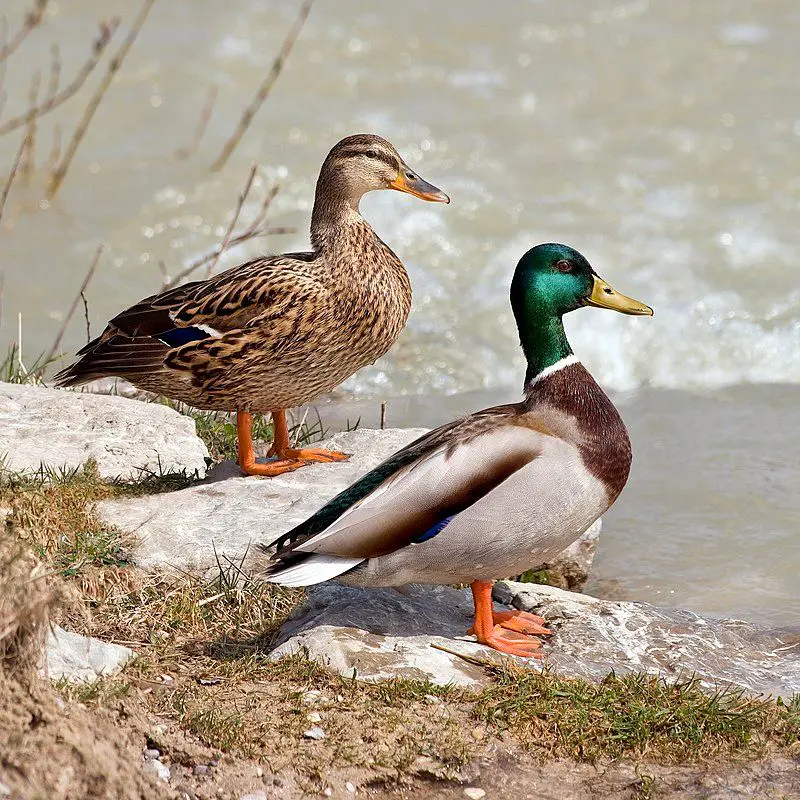
The mallard, also known as the wild duck, is a dabbling duck. It can be found breeding in various world regions, including the temperate and subtropical Americas, Eurasia, and North Africa.
This duck species has been introduced to several countries outside its native range. For example, mallards have been brought to New Zealand, Australia, Peru, Brazil, Uruguay, Argentina, Chile, Colombia, the Falkland Islands, and South Africa.
The mallard’s ability to adapt to different environments has allowed it to thrive in these introduced regions. It is a versatile bird that can adapt to various habitats, such as wetlands, ponds, lakes, and even urban areas. In its native range, the mallard is a migratory bird.
However, in some introduced areas, it has become resident, meaning it stays in one place throughout the year rather than undertaking long-distance migrations.
The mallard is known for its vibrant plumage, with males having a distinctive green head, yellow bill, and brownish body. Conversely, females have a mottled brown appearance, which helps them camouflage with their surroundings. As dabbling ducks, mallards feed.
| Kingdom | Animalia |
| Phylum | Chordata |
| Clade | Dinosauria |
| Class | Aves |
| Order | Anseriformes |
| Family | Anatidae |
| Genus | Anas |
| Species | A. platyrhynchos |
20. Dark-Eyed Junco
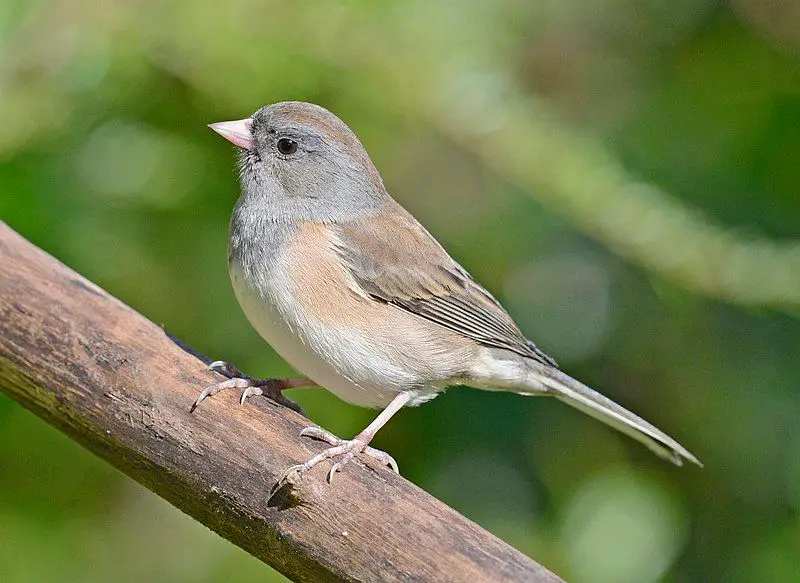
The dark-eyed junco is a type of bird called a junco. Juncos are small, grayish sparrows that live in the New World. The dark-eyed junco is found in many parts of temperate North America; during the summer, it even goes as far as the Arctic.
The dark-eyed junco is a species that has a lot of variation. This means that different individuals of this bird can look quite different from one another. It is similar to another species of sparrow called the fox sparrow in terms of its variability.
Despite being studied by scientists, the systematics of the dark-eyed junco are still not fully understood. Systematics refers to exploring the relationships between different species and their classification.
So, even though researchers have been trying to figure out how the dark-eyed junco fits into the larger picture of bird species, there are still some unanswered questions.
| Kingdom | Animalia |
| Phylum | Chordata |
| Clade | Dinosauria |
| Class | Aves |
| Order | Passeriformes |
| Family | Passerellidae |
| Genus | Junco |
| Species | J. hyemalis |
21. Downy Woodpecker
The downy woodpecker is a type of bird known as a woodpecker. It is the smallest species of woodpecker found in North America. Its size can range from 14 to 18 centimeters.
These woodpeckers can be found in various forested areas across the United States and Canada.
However, they are not commonly seen in desert regions in the southwest or the northern tundra. Due to their small size, downy woodpeckers are well-adapted to living in forested environments.
They can navigate through the trees and search for food more quickly than larger woodpecker species. One exciting feature of the downy woodpecker is its ability to drum on trees.
This drumming serves multiple purposes, including communication with other woodpeckers and marking its territory. The diet of the downy woodpecker primarily consists of insects and larvae found within the trees.
They use their strong beaks to peck at the bark and wood, uncovering their prey. These woodpeckers are known for their distinct black and white plumage. They have a white belly and back, with black wings and a black head. This coloration helps them blend in with the tree.
| Kingdom | Animalia |
| Phylum | Chordata |
| Clade | Dinosauria |
| Class | Aves |
| Order | Piciformes |
| Family | Picidae |
| Genus | Dryobates |
| Species | D. pubescens |
22. Steller’s Jay
The Steller’s jay is a type of bird found in western North America and the mountains of Central America. It is closely related to another bird called the blue jay, commonly found in eastern North America.
However, the Steller’s jay is the only jay with a crest that can be found west of the Rocky Mountains. The Steller’s jay is known for its striking appearance. It has a deep blue plumage with black markings on its head, wings, and tail.
One of its most distinctive features is its crest, a collection of feathers on top of its head that can be raised or lowered depending on its mood or level of excitement. Regarding habitat, the Steller’s jay prefers forests and woodlands, especially those with coniferous trees.
It is often seen perched on tree branches or hopping around on the forest floor, searching for food. These birds are pretty agile and are known for their ability to fly quickly and maneuver through dense vegetation. Steller’s jays are omnivores, meaning they eat a variety of foods.
Their diet includes insects, nuts, seeds, berries, and even small vertebrates like lizards or birds.
| Kingdom | Animalia |
| Phylum | Chordata |
| Clade | Dinosauria |
| Class | Aves |
| Order | Passeriformes |
| Family | Corvidae |
| Genus | Cyanocitta |
| Species | C. stelleri |
23. American Robin
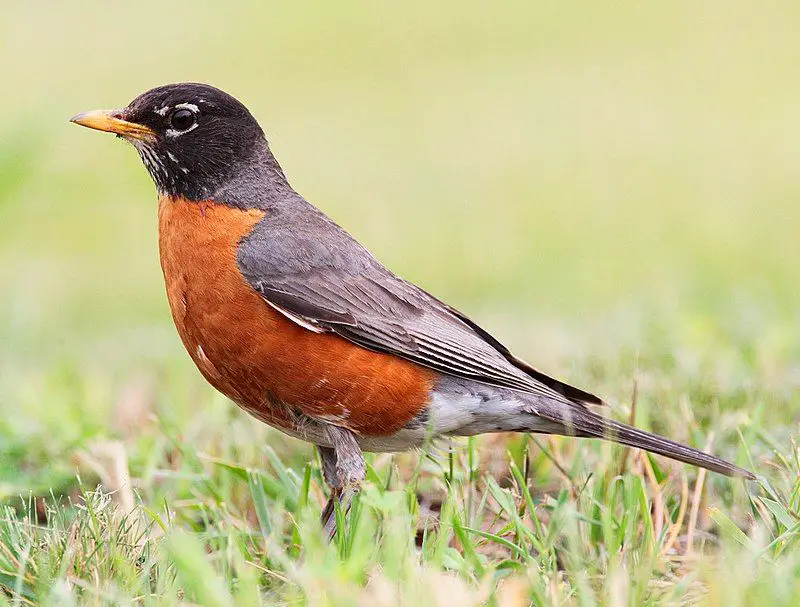
The American robin is a type of bird that migrates. It belongs to the valid thrush genus and the Turdidae family, a more prominent thrush family. It gets its name from the European robin because of its reddish-orange breast.
However, it must be noted that the American and European robin are not closely related. The European robin is a different species and belongs to the Old World flycatcher family.
Despite their similar names and physical characteristics, these two birds are not closely related regarding their genetic makeup.
They may share some similarities in appearance, such as the reddish-orange breast, but their evolutionary paths have taken them in different directions. The American robin is primarily found in North America, while the European robin is native to Europe and parts of Asia.
Both species have adapted to their respective environments and habitats over time.
The American robin is known for its ability to migrate long distances, often traveling south during winter and returning north for breeding season. Regarding physical characteristics, the American robin is larger than the European robin.
It has a grayish-brown back and a distinct reddish-orange breast, a defining feature of the species.
| Kingdom | Animalia |
| Phylum | Chordata |
| Clade | Dinosauria |
| Class | Aves |
| Order | Passeriformes |
| Family | Turdidae |
| Genus | Turdus |
| Species | T. migratorius |
24. Rufous Hummingbird
The rufous hummingbird is tiny, measuring only about 8 cm in length. It has a distinctive long, straight, and slender bill, which it uses to feed on flower nectar. These birds are renowned for their exceptional flight abilities.
During their migratory journeys, they can cover an astonishing distance of up to 2,000 miles. The rufous hummingbird belongs to the Selasphorus genus, which comprises nine species.
Each species within this genus shares similar characteristics and features. However, the rufous hummingbird is unique in its way. These birds’ flight skills are truly remarkable.
They can hover in mid-air, fly forward and backward, and even fly upside down. Their wings beat incredibly fast, allowing them to stay in one place while feeding on nectar.
This agile flight pattern also enables them to catch small insects mid-air, which they supplement their diet. During their long migratory transits, rufous hummingbirds travel vast distances.
They undertake these journeys in search of suitable breeding grounds and food sources. Despite their small size, these birds possess impressive endurance and determination to reach their destinations.
| Kingdom | Animalia |
| Phylum | Chordata |
| Clade | Strisores |
| Class | Aves |
| Order | Apodiformes |
| Family | Trochilidae |
| Genus | Selasphorus |
| Species | S. rufus |
25. Chestnut-Backed Chickadee
The chestnut-backed chickadee is a small bird that belongs to the tit family, known as Paridae. It used to be called Parus rufescens. This bird is commonly found in the Pacific Northwest region of the United States and western parts of Canada.
It can be seen in areas ranging from southeastern Alaska to southwestern California. The chestnut-backed chickadee prefers to live in regions near the coast with a humid and foggy climate. It tends to stay close to the shoreline.
These birds are known for their distinct appearance. They have a chestnut-colored back, which gives them their name. They also have a black cap on their head and a white face. The rest of their body is a grayish color.
The chestnut-backed chickadee is a passerine bird, meaning it sings and communicates through its melodious songs. It is known for its cheerful and lively calls, which can be heard throughout the day. These birds are highly active and agile.
They often hopped and flew from tree to tree, searching for food. They have a varied diet that includes insects, seeds, berries, and small fruits. The chestnut-backed chickadee is a social.
| Kingdom | Animalia |
| Phylum | Chordata |
| Clade | Dinosauria |
| Class | Aves |
| Order | Passeriformes |
| Family | Paridae |
| Genus | Poecile |
| Species | P. rufescens |
26. Song Sparrow
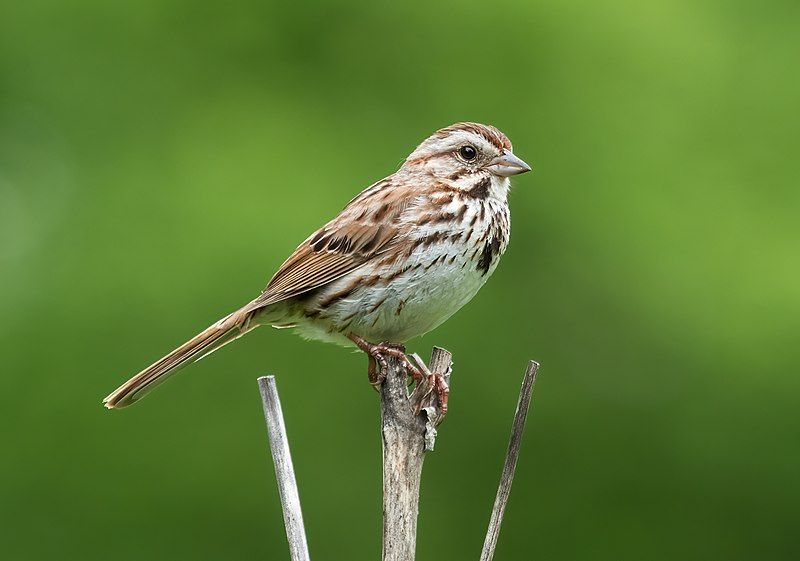
The song sparrow is a type of sparrow found in North America. It is considered to be medium-sized in comparison to other sparrows. Out of all the sparrows native to North America, the song sparrow is known to be one of the most abundant species.
This means that there are a large number of song sparrows in the wild. Not only is the song sparrow abundant, but it is also quite variable. This means that there can be different variations or types of song sparrows. They may have slight differences in appearance or behavior.
In addition to being abundant and variable, the song sparrow is also adaptable. This means that it can adjust well to different environments and conditions. It can thrive in various habitats, such as grasslands, marshes, and urban areas.
The adaptability of the song sparrow allows it to have a wide range of distribution. It can be found in many parts of North America, from Canada to Mexico. The song sparrow is a fascinating, medium-sized, abundant, variable, and adaptable bird.
Its ability to adapt to different environments has contributed to its success as a species in North America.
| Kingdom | Animalia |
| Phylum | Chordata |
| Clade | Dinosauria |
| Class | Aves |
| Order | Passeriformes |
| Family | Passerellidae |
| Genus | Melospiza |
| Species | M. melodia |
27. Yellow-Rumped Warbler
The yellow-rumped warbler is a type of bird found in North America. It is pretty standard and can be seen everywhere across the continent. This bird species is known for its distinct yellow feathers on its rump or lower back.
This is where it gets its name from. These yellow feathers make it easy to identify the yellow-rumped warbler in the wild. The yellow-rumped warbler is a small bird, measuring around 5 to 6 inches in length. It has a slim body with a pointed beak and long wings.
Its wingspan can reach 9 to 10 inches, allowing it to fly swiftly and gracefully. One interesting fact about this bird is that it is known for its ability to migrate long distances. Yellow-rumped warblers can be found in North America during the breeding season.
However, they migrate south to warmer regions, such as Mexico and Central America, when winter arrives. This bird species can be found in a variety of habitats. It is often seen in forests, woodlands, and even urban areas.
It has adapted well to different environments and can thrive in deciduous and coniferous forests. The yellow-rumped warbler has a diverse.
| Kingdom | Animalia |
| Phylum | Chordata |
| Clade | Dinosauria |
| Class | Aves |
| Order | Passeriformes |
| Family | Parulidae |
| Genus | Setophaga |
| Species | S. coronata |
28. Loons
Loons, also known as divers, are a type of bird that live in water. They can be found in various parts of North America and northern Eurasia. When we talk about loons, we refer to different species of birds belonging to the same group.
All the species of loons today are classified under the scientific name “Gavia.” Loons are part of the Gaviidae family, and the order is called Gaviiformes. This means that they are closely related to each other and share common characteristics.
The family Gaviidae includes all the different species of loons, while the order Gaviiformes also includes other waterbird species. The fact that loons are found in North America and northern Eurasia indicates a wide distribution across these regions.
This suggests that they are well adapted to various environments and habitats found in these areas. Being aquatic birds, loons are well adapted for life in the water. They have unique features that help them swim and catch prey underwater.
Their bodies are streamlined, and their legs are positioned far back on them, making them excellent divers. They have webbed feet that enable them to propel themselves through the water.
| Kingdom | Animalia |
| Phylum | Chordata |
| Clade | Dinosauria |
| Class | Aves |
| Order | Gaviiformes |
| Family | Gaviidae |
| Genus | Gavia |
29. Ruby-Crowned Kinglet
The ruby-crowned kinglet is a small bird found all over North America. It belongs to the kinglet family, which includes other small bird species. This bird has olive-green feathers that cover its body.
Additionally, it has two white bars on its wings and a white ring around its eye. If we look closely, we can notice some differences between males and females of the species. The male ruby-crowned kinglet has a unique feature on its head – a red patch on its crown.
However, this patch is not always visible as it is often hidden. On the other hand, female ruby-crowned kinglets do not have this red crown patch. Despite their small size, these birds are known for their energetic and active behavior.
They are constantly flying and hopping from branch to branch for food. Ruby-crowned kinglets feed on insects, spiders, and small invertebrates in trees and shrubs. One interesting fact about these birds is that they are known to be quite vocal.
They produce a variety of sounds to communicate with each other. Their songs consist of high-pitched and rapid notes, which can be quite melodic and pleasant to hear. During the breeding season, male ruby-crowned.
| Kingdom | Animalia |
| Phylum | Chordata |
| Clade | Dinosauria |
| Class | Aves |
| Order | Passeriformes |
| Family | Regulidae |
| Genus | Corthylio |
| Species | C. calendula |
30. Golden-Crowned Kinglet
The golden-crowned kinglet is a bird species belonging to the family Regulidae. It is known for its small size and beautiful golden crown.
This bird can be found in various regions across North America, making it quite widespread. Despite its small size, the golden-crowned kinglet is known for its energetic nature and lively behavior. It is often seen flitting about in trees and shrubs, constantly on the move.
This bird is quite active and always seems to be searching for insects and spiders to feed on. One of the distinguishing features of the golden-crowned kinglet is its vibrant plumage.
Its body is primarily olive-gray, with white undersides and a bright yellow stripe running over its head.
This stripe gives the bird its name, as it resembles a regal golden crown. The golden-crowned kinglet is exceptionally skilled at hiding within the foliage of trees.
Its small size and camouflage plumage allow it to blend in seamlessly with its surroundings. This helps protect the bird from predators and makes it more challenging to spot in the wild. This species of kinglet is known for its melodious song.
| Kingdom | Animalia |
| Phylum | Chordata |
| Clade | Dinosauria |
| Class | Aves |
| Order | Passeriformes |
| Family | Regulidae |
| Genus | Regulus |
| Species | R. satrapa |
31. Buff-Bellied Pipit
The buff-bellied pipit, also known as the American pipit, is a little bird in the northern Pacific region. It was first identified and described by a person named Marmaduke Tunstall in his book Ornithologia Britannica in 1771.
Previously, it was categorized as a type of water pipit. The buff-bellied pipit is a small songbird commonly seen in the areas surrounding the northern Pacific Ocean. It is known for its distinct appearance and behavior.
This bird was given its name due to the buff-colored belly feathers it possesses. The rest of its body is generally brownish or grayish, allowing it to blend in with its surroundings. The American pipit is known for its beautiful and melodious song.
It is often heard singing unique tunes while perched on trees or flying through the air.
This song is essential for the bird to communicate with others, establish its territory, and attract potential mates.
The discovery of the buff-bellied pipit dates back to the 18th century when Marmaduke Tunstall, a British ornithologist, first described it in his book Ornithologia Britannica.
| Kingdom | Animalia |
| Phylum | Chordata |
| Clade | Dinosauria |
| Class | Aves |
| Order | Passeriformes |
| Family | Motacillidae |
| Genus | Anthus |
| Species | A. rubescens |
32. Lincoln’s Sparrow
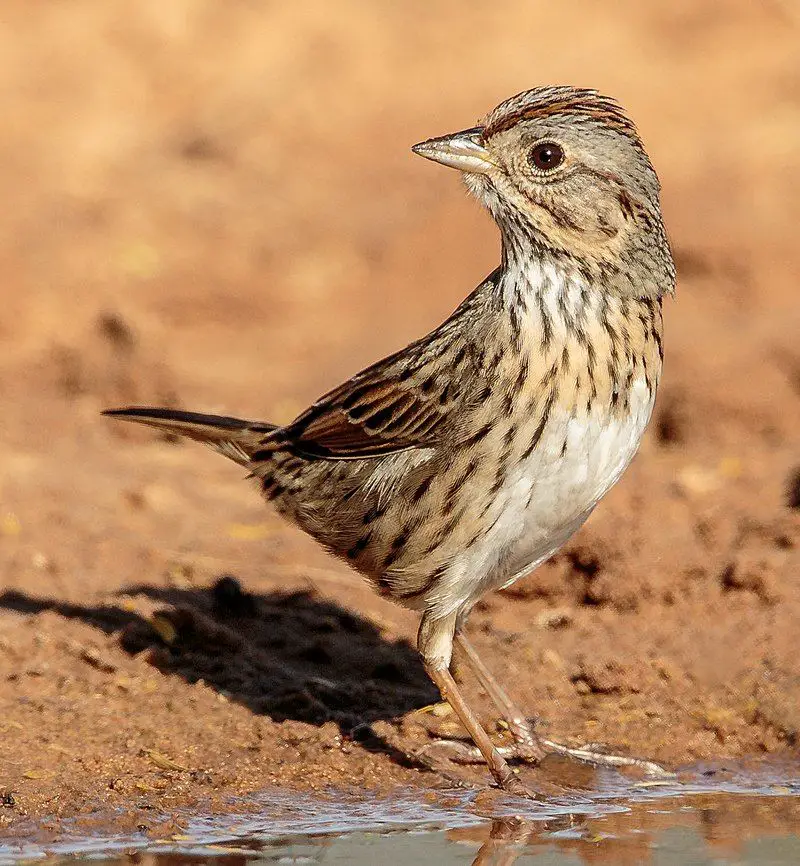
The Lincoln’s sparrow is a type of bird found in North America. It is relatively small in size and belongs to the sparrow family. This bird is uncommon, as it hides under dense ground cover.
Due to its elusive nature, spotting a Lincoln’s sparrow can be pretty challenging. One of the distinguishing characteristics of the Lincoln’s sparrow is its beautiful song. It has a sweet and melodious call that resembles the song of a wren.
This unique vocalization makes it easier to identify this specific species of sparrow.
It is interesting to note that the song of Lincoln’s sparrow is often heard before the bird itself is seen. Because it prefers staying hidden, the Lincoln’s sparrow is frequently spotted in areas with dense vegetation or shrubs.
It tends to avoid open spaces and prefers habitats with thick ground cover.
This behavior allows the bird to conceal itself and reduces the risk of being detected by predators or humans. The Lincoln’s sparrow has a brownish coloration on its back and wings, while its underparts are pale and streaked.
This coloring provides effective camouflage when the bird is nestled among the vegetation. It has a relatively short and rounded tail.
| Kingdom | Animalia |
| Phylum | Chordata |
| Clade | Dinosauria |
| Class | Aves |
| Order | Passeriformes |
| Family | Passerellidae |
| Genus | Melospiza |
| Species | M. lincolnii |
33. Emperor Goose
The emperor goose is a type of bird that belongs to the Anatidae family. This family includes various waterfowl species, including ducks, geese, and swans.
Other names like the beach or painted goose, also known as the emperor goose. During winter, the emperor goose can be found in specific habitats, like mudflats and coasts.
These habitats are primarily located in Alaska, but occasionally, they can also be found in Canada and the contiguous United States. The emperor goose is well-adapted to living in these environments.
Mudflats provide ample access to food sources, particularly aquatic plants and invertebrates. These birds have specialized beaks that quickly filter out food from the mud and water. Coastal areas also offer the emperor goose protection and safety.
These birds are naturally skilled swimmers and can navigate the waters with ease. The coast provides them a safe place to rest and seek shelter when needed. Alaska is a critical location for the emperor goose during the winter.
The state offers various suitable habitats for these birds, including coastal wetlands, estuaries, and shallow bays. These areas provide an abundance of food.
| Kingdom | Animalia |
| Phylum | Chordata |
| Clade | Dinosauria |
| Class | Aves |
| Order | Anseriformes |
| Family | Anatidae |
| Genus | Anser |
| Species | A. canagicus |
34. Willow Ptarmigan
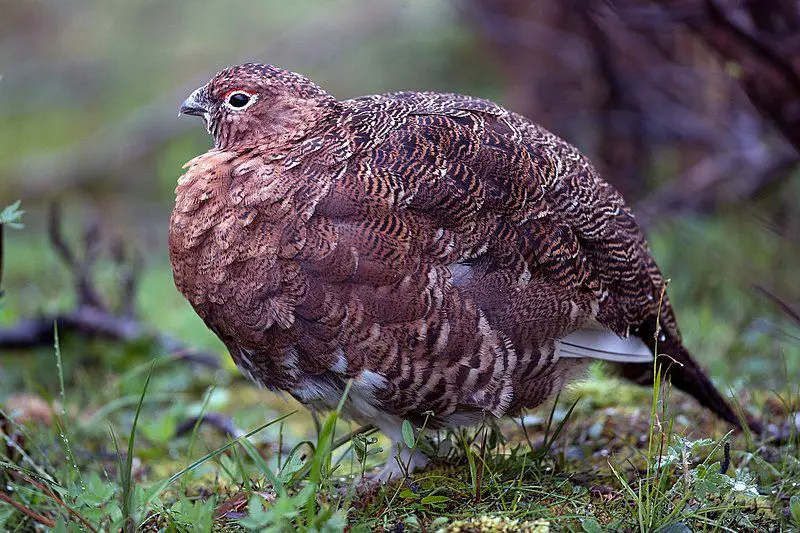
The willow ptarmigan is a type of bird that belongs to the grouse subfamily called Tetraoninae. It is also a member of the pheasant family known as Phasianidae. This bird is commonly referred to as the willow grouse.
In Ireland and Britain, there is a subspecies of the willow ptarmigan called L. l. scotia. In the past, this subspecies was considered to be a separate species on its own, known as the red grouse.
However, it is now recognized as part of the willow ptarmigan species. The willow ptarmigan is a bird known for its ability to adapt to various habitats. It is found in regions with willow shrubs, where its name comes from.
These birds are usually found in the northern parts of North America, Europe, and Asia. One attractive characteristic of the willow ptarmigan is its ability to change its plumage according to the season.
During the winter, its feathers are mainly white, which helps it blend in with the snowy surroundings. In the summer, its plumage changes to a mix of brown, black, and white, which provides camouflage.
| Kingdom | Animalia |
| Phylum | Chordata |
| Clade | Dinosauria |
| Class | Aves |
| Order | Galliformes |
| Family | Phasianidae |
| Genus | Lagopus |
| Species | L. lagopus |
35. White-Crowned Sparrow
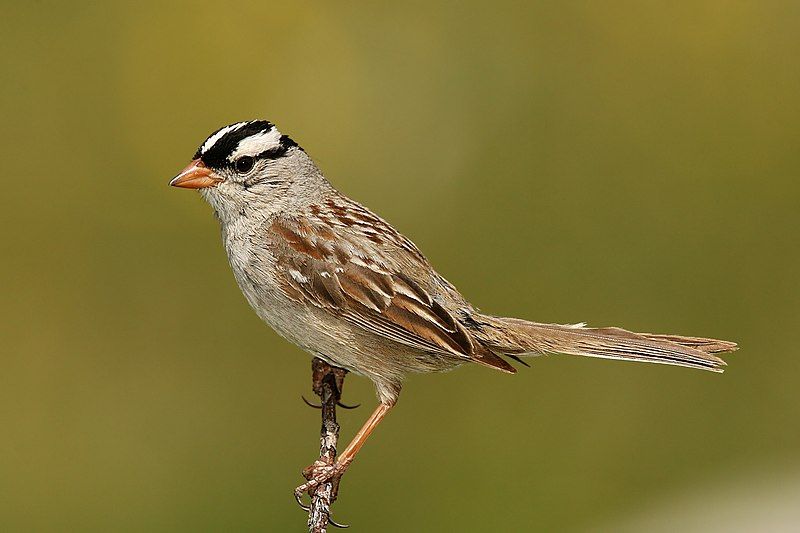
The white-crowned sparrow is a type of bird found in North America. It belongs to the passerine bird family, which means it is a perching bird.
This species is not too big or too small but falls into the category of medium-sized birds. One distinctive feature of the white-crowned sparrow is its grey face. The color of its face is different from the rest of its body, making it easy to identify.
The grey color gives the bird a unique and exciting appearance. Another characteristic of this species is the black and white streaking on its upper head. The streaks create a pattern that adds to the bird’s overall appearance.
These streaks are alternating black and white lines, giving the bird a striking and beautiful look. The black and white streaking on the white-crowned sparrow’s upper head is a notable feature because it contrasts with the rest of its body.
This contrast makes the bird stand out and catch the eye of observers. Seeing how nature has designed this bird with such distinct markings is interesting. The white-crowned sparrow’s grey face and black and white streaking on the upper head are unique to this species.
These characteristics help distinguish it from others.
| Kingdom | Animalia |
| Phylum | Chordata |
| Clade | Dinosauria |
| Class | Aves |
| Order | Passeriformes |
| Family | Passerellidae |
| Genus | Zonotrichia |
| Species | Z. leucophrys |
36. Trumpeter Swan
The trumpeter swan is a type of swan found in North America. It is known for being the heaviest bird native to this region. It also holds the title of being the largest existing species of waterfowl.
One of its remarkable features is its impressive wingspan, which can range from 185 to 304.8 centimeters. These swans are found explicitly in North America, making them a unique and memorable part of the region’s wildlife.
Being the heaviest bird in the area, they have a notable presence that sets them apart from other bird species. The trumpeter swan is also distinctive for its exceptional size among waterfowl species. Its large wingspan allows it to soar with grace and elegance.
This impressive feature allows the swan to cover a significant distance while flying. It is interesting to note that the wingspan of the trumpeter swan can vary between 185 to 304.8 centimeters.
This means there can be quite a difference in size among individual birds of this species. Some may have a shorter wingspan of 185 centimeters, while others may reach an impressive wingspan of 304.8.
| Kingdom | Animalia |
| Phylum | Chordata |
| Clade | Dinosauria |
| Class | Aves |
| Order | Anseriformes |
| Family | Anatidae |
| Genus | Cygnus |
| Species | C. buccinator |
37. Great Grey Owl
The great grey owl is a type of owl, and it is known for being the largest species of owl in terms of length. It can be found in various parts of the world, particularly in the Northern Hemisphere.
Interestingly, this owl is unique because it is the only species within its genus, called Strix, that exists in both the Eastern and Western Hemispheres. The great grey owl’s large size sets it apart from other owl species.
It can grow about 61 to 84 centimeters long, making it an impressive bird. Its body is covered in beautiful grey feathers, which give it its name.
These feathers help the owl blend in with its surroundings, providing excellent camouflage in its natural habitat. Regarding distribution, the great grey owl can be found across the Northern Hemisphere.
It can be seen in various countries such as Canada, the United States, Russia, and Europe.
This wide distribution range shows that the great grey owl has adapted to different climates and environments. In terms of behavior, the great grey owl is known for being a skilled hunter.
It primarily feeds on small mammals, such as voles and mice, which it catches using its sharp talons.
| Kingdom | Animalia |
| Phylum | Chordata |
| Clade | Dinosauria |
| Class | Aves |
| Order | Strigiformes |
| Family | Strigidae |
| Genus | Strix |
| Species | S. nebulosa |
38. Common Starling
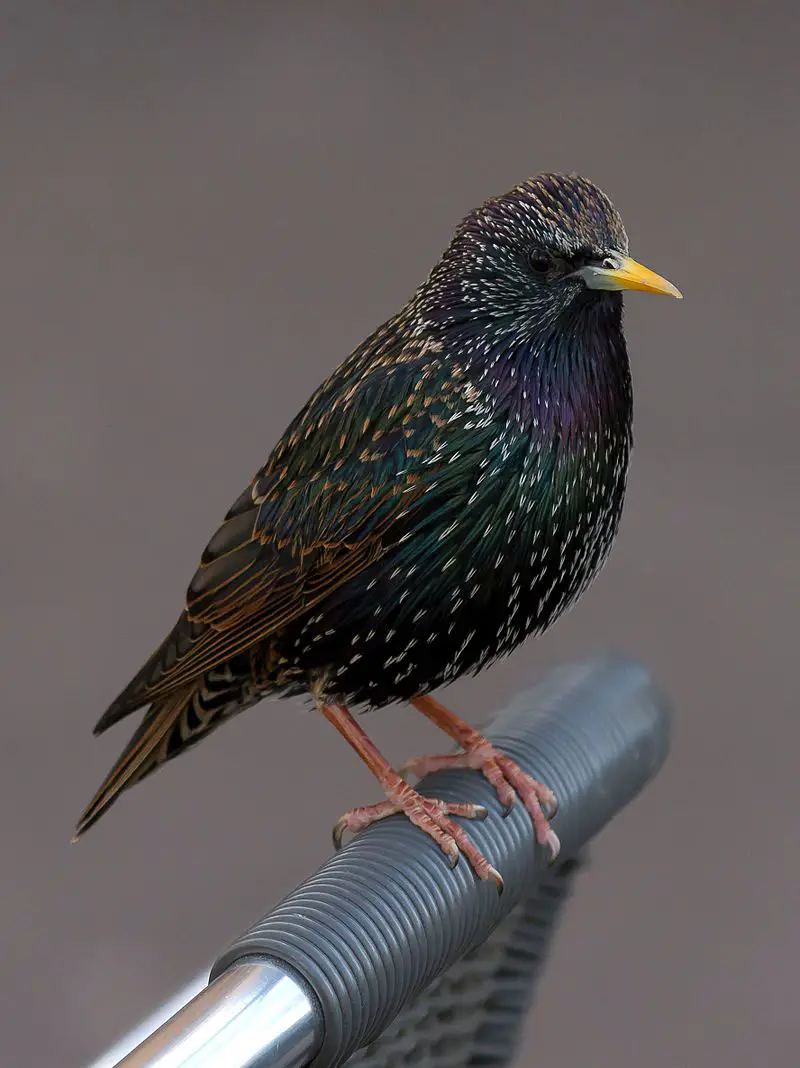
The common starling is a type of bird found in various regions. Depending on the location, it is referred to by different names. It is known as the European starling in North America, while it is called the starling in Great Britain and Ireland.
This bird belongs to the starling family, scientifically known as Sturnidae. The common starling is classified as a passerine bird with its medium-sized build. Passerine birds are characterized by having feet adapted for perching, and they make up the most significant order of birds.
The starling family, to which the common starling belongs, is known for its diverse species worldwide. The common starling is known for its unique features and behaviors. It has a sleek and shiny black plumage with speckled spots, which gives it a distinct appearance.
The bird’s feathers can also appear iridescent in certain lighting conditions, showcasing shades of green and purple. One of the remarkable aspects of the common starling is its ability to mimic sounds and voices.
It has various vocalizations and can imitate multiple sounds in its environment, including other bird calls, human speech, and even mechanical noises.
| Kingdom | Animalia |
| Phylum | Chordata |
| Clade | Dinosauria |
| Class | Aves |
| Order | Passeriformes |
| Family | Sturnidae |
| Genus | Sturnus |
| Species | S. vulgaris |
39. Arctic Redpoll
The Arctic redpoll, also known as the hoary redpoll, is a type of bird that belongs to the finch family called Fringillidae. It is found in various regions, specifically in tundra birch forests. This bird species has two distinct subspecies. The first one is called A. h.
Horseman, which can be found in Greenland and some parts of Canada. The second subspecies is known as A. h.
Exiles, and it breeds in the northern North America and the Palearctic tundra regions. The Arctic redpoll is a fascinating bird species that has adapted to survive in its unique habitat.
It is commonly found in tundra birch forests, characterized by cold climates and sparse vegetation. This bird species has evolved to thrive in these harsh conditions. The Arctic redpoll has two subspecies, each with its distinct breeding range.
The first subspecies, A. h. hornemanni, is primarily found in Greenland and neighboring areas of Canada. These birds have adapted to the extreme cold temperatures and limited food availability in their environment. The second subspecies, A. h.
exiles, breeds in the tundra regions of northern North America.
| Kingdom | Animalia |
| Phylum | Chordata |
| Clade | Dinosauria |
| Class | Aves |
| Order | Passeriformes |
| Family | Fringillidae |
| Genus | Acanthis |
| Species | A. hornemanni |
40. Red-Winged Blackbird
The red-winged blackbird is a type of bird that belongs to the passerine family called Icteridae.
It is commonly found in various parts of North America and a significant portion of Central America. Passerines are a diverse group of birds known for their musical and complex songs.
They have specialized vocal organs that produce a wide range of sounds. The red-winged blackbird is easily recognizable due to its distinct appearance.
The male red-winged blackbird has glossy black plumage and bright red patches on its wings, which give it its name.
On the other hand, the female red-winged blackbird has a more subdued appearance with brown feathers and streaks. These birds have a unique habitat preference, as they are commonly found in wetlands, marshes, and areas with tall grasses.
They are skilled at perching on tall plants and reeds, where they can easily spot their prey and potential predators. Red-winged blackbirds primarily feed on insects, seeds, and grains. They use their sharp beaks to catch insects on the fly and extract seeds from plants.
During the breeding season, they may consume small vertebrates such as frogs and tadpoles.
| Kingdom | Animalia |
| Phylum | Chordata |
| Clade | Dinosauria |
| Class | Aves |
| Order | Passeriformes |
| Family | Icteridae |
| Genus | Agelaius |
| Species | A. phoeniceus |
41. Common Loon
The paragraph describes a bird known as the common loon or great northern diver. This bird belongs to the loon family, a type of diving bird. When the common loon reaches breeding age, it develops a distinct plumage.
This plumage consists of a broad black head and neck. Additionally, the head and neck may have shades of greenish or purplish coloration. The plumage of the common loon is an essential characteristic for identifying this bird.
It helps distinguish it from other species in the loon family. During the breeding season, the plumage of the common loon serves a purpose. It aids in attracting a mate and establishing territorial boundaries.
The black coloration on the head and neck of the common loon is particularly prominent. It creates a striking contrast against the water or snow, making the bird easily visible.
The greenish or purplish hues observed on the common loon’s head and neck add an element of visual interest. They contribute to the overall beauty and uniqueness of this bird’s appearance.
It is fascinating how the common loon’s plumage can vary in color, as some individuals may have more greenish tones.
| Kingdom | Animalia |
| Phylum | Chordata |
| Clade | Dinosauria |
| Class | Aves |
| Order | Gaviiformes |
| Family | Gaviidae |
| Genus | Gavia |
| Species | G. immer |
42. Old World Sparrows
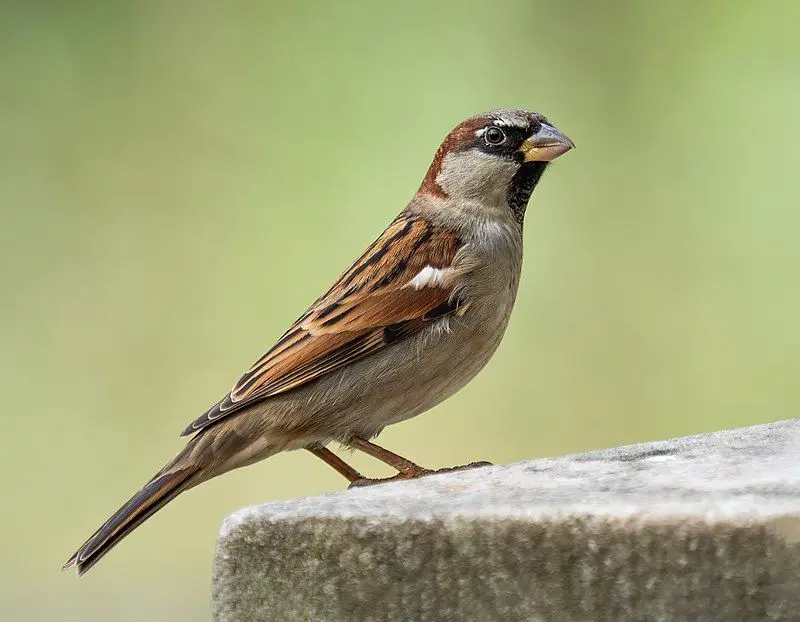
Old World sparrows belong to the family Passeridae, a group of small passerine birds. These birds are commonly referred to as true sparrows.
However, it is essential to note that the term “true sparrows” is also used specifically for a particular genus within the Passeridae family called Passer. Passeridae is a family of birds that includes various species of sparrows.
These birds are found primarily in the Old World, which refers to the continents of Europe, Asia, and Africa.
They are well-known for their small size and characteristic features such as short, stout bills and rounded wings. The term “Old World sparrows” distinguishes these birds from their New World counterparts, including the Americas.
While there are some similarities between the two groups, Old World sparrows have distinct characteristics that set them apart. Old World sparrows are known for their adaptability and ability to thrive in various environments.
They can be found in various habitats, including grasslands, forests, urban areas, and agricultural landscapes.
These birds have successfully adapted to human-altered environments, often nesting in buildings and feeding on human-provided food sources. The genus Passer is a specific.
| Kingdom | Animalia |
| Phylum | Chordata |
| Clade | Dinosauria |
| Class | Aves |
| Order | Passeriformes |
| Family | Passeridae |
43. Varied Thrush
The varied thrush is a bird that belongs to the thrush family, known as Turdidae. This family includes other birds like robins and bluebirds.
However, the varied thrush is unique because it is the only species in its Ixoreus genus. Being a member of the thrush family means that the varied thrush shares specific characteristics with other birds in this family.
Thrushes are typically medium-sized birds with plump bodies and rounded wings. They have strong beaks that help them catch and eat insects, berries, and other small creatures. The varied thrush, specifically, is known for its striking appearance.
It has a vibrant orange breast and belly, contrasting with a dark blue-gray back and head. This combination of colors makes it a visually appealing bird to observe.
Additionally, the varied thrush has a distinct white stripe above its eyes, which adds to its unique look. This bird is native to the western parts of North America, including Alaska, Canada, and the Pacific Northwest of the United States.
It prefers forested areas, especially coniferous trees like spruce and fir. The varied thrush is known for its beautiful song, consisting of a flute-like series.
| Kingdom | Animalia |
| Phylum | Chordata |
| Clade | Dinosauria |
| Class | Aves |
| Order | Passeriformes |
| Family | Turdidae |
| Genus | Ixoreus |
| Species | I. naevius |
44. Snow Bunting
The snow bunting is a type of bird that belongs to the passerine family called Calcariidae. This family includes various species of birds known for their perching abilities. Unlike many other birds, the snow bunting is specially adapted to survive in the Arctic.
It is considered an Arctic specialist because its unique features help it thrive in this cold and harsh environment. One of the distinctive characteristics of the snow bunting is its circumpolar Arctic breeding range.
This means it can be found breeding throughout the entire Arctic region in the northern hemisphere. It can survive and reproduce in areas with extreme temperatures and limited resources.
The circumpolar Arctic breeding range of the snow bunting indicates that it is well adapted to the Arctic conditions. It can be found in various countries, such as Canada, Greenland, Iceland, Russia, and Norway.
It can find suitable breeding grounds and sufficient food sources in these regions. During the breeding season, the snow bunting constructs its nests on the ground in open areas such as tundra or rocky slopes.
This nesting behavior helps protect the eggs and young birds from predators, as the open environment allows for better visibility.
| Kingdom | Animalia |
| Phylum | Chordata |
| Clade | Dinosauria |
| Class | Aves |
| Order | Passeriformes |
| Family | Calcariidae |
| Genus | Plectrophenax |
| Species | P. nivalis |
45. Winter Wren
The winter wren is a tiny bird found in North America. It belongs to the Troglodytidae family, mainly consisting of wrens in the New World.
In the past, it was considered the same species as the Pacific wren in western North America and the Eurasian wren in Eurasia.
However, it is now recognized as a distinct species called the winter wren. The winter wren is known for its small size and is one of the smallest birds in North America.
It can be found in coniferous forests, dominated by cone-bearing trees like pine, spruce, and fir. Its habitat ranges from British Columbia in Canada to the Atlantic Ocean. This little bird is known for its distinctive behavior and appearance.
It has a compact body with short wings and a short tail, making it well-suited for navigating through dense forest vegetation.
Its plumage is usually dark brown with fine streaks on its back and a light-colored throat and belly. During the breeding season, which generally occurs in the spring and summer, the winter wren builds its nest in tree cavities or among tree roots.
The male wren is known for its beautiful and melodious song.
| Kingdom | Animalia |
| Phylum | Chordata |
| Clade | Dinosauria |
| Class | Aves |
| Order | Passeriformes |
| Family | Troglodytidae |
| Genus | Troglodytes |
| Species | T. hiemalis |
46. Snowy Owl
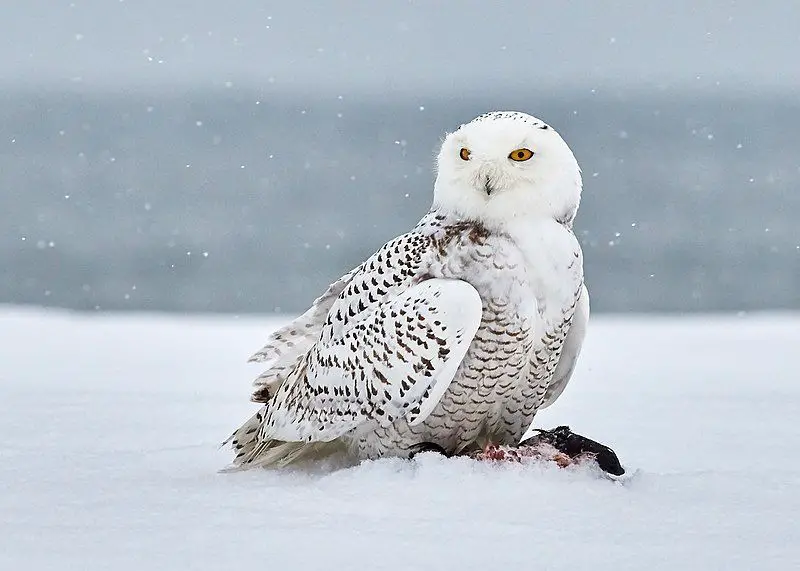
The snowy owl is a type of owl known by other names, such as polar, white, and Arctic owl. It belongs to the true owl family and is characterized by its large size and white feathers.
These owls can be found in both North America and the Palearctic regions, specifically in the Arctic areas. Snowy owls are well adapted to their harsh Arctic environments.
They have evolved to blend in with the snowy landscapes, which helps them remain camouflaged and hidden from predators.
Their white feathers act as a protective cover, allowing them to hunt and survive in their habitat. One interesting fact about snowy owls is that they are predominantly found in the tundra regions.
The tundra is a cold and treeless biome characterized by low temperatures and short summers. This environment provides ideal conditions for the snowy owl’s breeding. During the breeding season, snowy owls build their nests on the ground.
They use the tundra’s vegetation and materials like feathers and moss to construct their nests. This nesting behavior is unique among owls, as most other owl species prefer to nest in trees. Snowy owls feed primarily on small mammals, such as lemmings and voles.
| Kingdom | Animalia |
| Phylum | Chordata |
| Clade | Dinosauria |
| Class | Aves |
| Order | Strigiformes |
| Family | Strigidae |
| Genus | Bubo |
| Species | B. scandiacus |
47. Sandhill Crane
The sandhill crane is a type of bird. It is a large crane found in North America and extreme northeastern Siberia. Its common name comes from the habitat it prefers, similar to the Platte River. This river is located on the edge of Nebraska’s Sandhills.
The Sandhills are part of the American Great Plains. The sandhill crane is known for its distinctive appearance and behavior. It has long legs and a long neck, which allows it to stand tall and walk gracefully. The bird has a grayish-brown body with patches of red on its head.
It also has a long, pointed beak to catch and eat food. These cranes are highly adapted to living in wetland areas. They can be found in marshes, bogs, and shallow lakes. The Platte River, for example, provides an ideal habitat for them.
The river’s sandbars, wetlands, and surrounding grasslands offer a perfect environment for the sandhill cranes to forage and rest. During their migration, sandhill cranes form large flocks that can number thousands.
They fly in a V-formation, using the air currents to conserve energy.
| Kingdom | Animalia |
| Phylum | Chordata |
| Clade | Dinosauria |
| Class | Aves |
| Order | Gruiformes |
| Family | Gruidae |
| Genus | Antigone |
| Species | A. canadensis |
48. Tundra Swan
The tundra swan is a type of swan found in the Holarctic region. This region includes both the Nearctic and Palaearctic areas. The tundra swan is a small swan compared to other species of swans. There are two taxa, or groups, within the tundra swan.
These two groups are often considered the same species, but sometimes they are supposed to be two separate species.
The two taxa are known as Bewick’s swan and the whistling swan proper. Bewick’s swan is found in the Palaearctic region, which includes Europe and Asia.
It is named after Thomas Bewick, an English engraver who illustrated birds in the 18th century.
This subspecies of tundra swan is known for its distinctive appearance, with a small yellow patch on its bill. On the other hand, the whistling swan is proper in the Nearctic region, including North America.
It is called the whistling swan because of its high-pitched sound, similar to a whistle. This subspecies of tundra swan has an entirely black bill, distinguishing it from Bewick’s sw.
| Kingdom | Animalia |
| Phylum | Chordata |
| Clade | Dinosauria |
| Class | Aves |
| Order | Anseriformes |
| Family | Anatidae |
| Genus | Cygnus |
| Species | C. columbianus |
49. Mountain Chickadee
The mountain chickadee is a type of bird that is known for its small size. It belongs to the passerine bird family, which means it is a perching bird with three toes pointing forward and one toe pointing backward.
This family is also known as the tit family and is scientifically referred to as Paridae. Being a passerine bird, the mountain chickadee has a unique anatomy that allows it to perch on branches or other surfaces.
It has specialized feet with sharp claws help it grip onto branches securely.
This adaptation enables the bird to move around its habitat, including trees and bushes while foraging for food or searching for a suitable nesting site. The mountain chickadee is not only recognized for its small size but also for its melodious song.
It has a beautiful and distinctive call that it uses to communicate with other birds of its species.
This song is often heard during the breeding season when the males try to attract females or establish their territory. In terms of physical appearance, the mountain chickadee has a black cap on its head that extends down its throat, making it easily distinguishable.
It also has a grayish body with white patches on its wings and sides.
| Kingdom | Animalia |
| Phylum | Chordata |
| Clade | Dinosauria |
| Class | Aves |
| Order | Passeriformes |
| Family | Paridae |
| Genus | Poecile |
| Species | P. gambeli |
50. Glaucous-Winged Gull
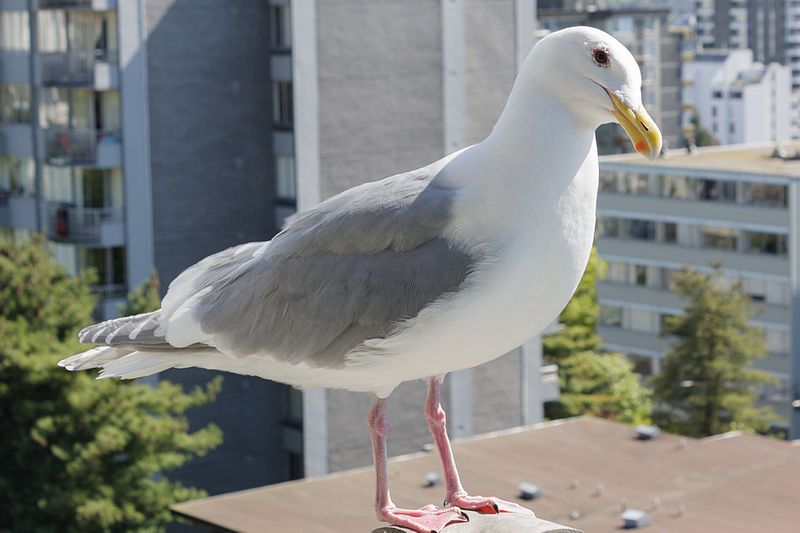
The glaucous-winged gull is a type of seagull with a white head. Its scientific name, Larus glaucescens, has an interesting origin. The genus name, Larus, comes from Latin and is believed to refer to a gull or another large seabird.
The specific name, glaucescens, is derived from Neo-Latin.
It is a combination of the word “glaucous,” which comes from Ancient Greek, and the suffix “-essence,” which means “becoming” or “turning into.”
The word “glaucous” in Ancient Greek means “grey” or “bluish-grey.” Therefore, the name glaucescens describes the grey color of the glaucous-winged gull’s wings.
This scientific naming system allows researchers and scientists to have a standardized way of identifying different species. Using Latin and Greek roots, they can create unique names that convey specific characteristics or attributes of the organism.
In the case of the glaucous-winged gull, its scientific name not only tells us that it belongs to the genus Larus, which is associated with gulls.
| Kingdom | Animalia |
| Phylum | Chordata |
| Clade | Dinosauria |
| Class | Aves |
| Order | Charadriiformes |
| Family | Laridae |
| Genus | Larus |
| Species | L. glaucescens |
Conclusion
Alaska is a prime destination for bird enthusiasts during the winter months. Despite the extreme weather conditions, a wide array of bird species can be found throughout the state, showcasing their remarkable adaptations for survival.
The unique habitat and abundance of food sources attract residents and migratory birds to seek refuge in this cold but bountiful environment.
Additionally, Alaska offers unparalleled opportunities for birdwatching and photography, allowing visitors and locals alike to witness the awe-inspiring beauty and behavior of these winter birds.
As we continue to appreciate and protect the habitats of these remarkable creatures, we ensure their continued presence for future generations to enjoy and learn from.